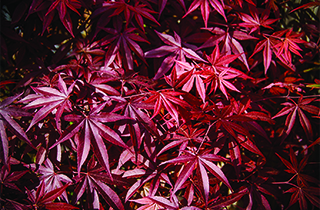This Tree Rules

Japanese maples are one of the best-loved groups of trees. There are many varieties, with obvious differences among some in overall size and shape; other types, however, can be hard to tell apart.
EMPEROR I JAPANESE MAPLE LOOKS MUCH LIKE THE COMMON VARIETY ‘Bloodgood.’ The difference is that Emperor I, Acer palmatum ‘Wolff’ is said to leaf out slightly later in the spring, protecting it from late spring freezes. Its leaves also hold their reddish-purple color better into the summer and display consistent scarlet fall color.
PLANT JAPANESE MAPLES IN PARTLY SHADY SITES. I find they perform better, even though many Japanese maples are said to grow well in full sun. Avoid extremely hot and dry locations, because most Japanese maples are susceptible to leaf burn. They perform best in a moist but well-drained soil.
CONSIDER OVERALL SIZE AND CHARACTERISTICS when choosing a site for a Japanese maple. Emperor I has an upright form and can reach 15 feet tall, but will often grow to be just as wide at maturity. While considered a small tree, it still needs ample room to grow and develop into its natural shape. Keep plantings under or around a Japanese maple simple or minimal to help show off the tree to its fullest potential.
JAPANESE MAPLES CAN BE QUITE EXPENSIVE, but the more common the variety, the smaller the price tag usually. You don’t have to buy a rare or unusual type to have a beautiful specimen in your garden, but do pick one that you will love and enjoy for years to come.
SHELLY NOLD is a horticulturist and owner of The Plant Kingdom. Send stories and ideas to her at The Plant Kingdom, 4101 Westport Road, Louisville, KY 40207.
ASK THE GARDENER
by Angie McManus
Q What type of flower keeps bugs out of the garden?
A Knowing which insects are harmful and which are actually helpful is the first step to preventing harmful infestations. There are some plants that can repel unwanted insects, but there are also plants that attract beneficial insects. These beneficial insects prey on pests that can potentially harm our plants.
I am not sure what you are trying to deter, but here are a few suggestions: marigolds and nasturtium both repel Colorado potato beetles, which tend to be a problem with, of course, potatoes, but also eggplant and tomatoes. Marigolds are good for deterring other beetles as well as aphids, which can affect a wide range of plants in the garden. Cornflowers attract ladybugs and beneficial wasps, citronella-scented geraniums repel mosquitoes, and garlic or chives are great for keeping unwanted insects out of the vegetable garden. Dill, fennel, and zinnias are all good for attracting beneficial insects, as well as borage and rue. In general, most herbs have repelling qualities because of their fragrance.
Using plant material to deter harmful insects is a great alternative to potentially harmful sprays. Good cultural practices are essential for maintaining a healthy garden. Be sure to weed and keep your beds free of fallen plant litter. Good air circulation is also important for insect control.
Have a Gardening Question?
Ask The Gardener

